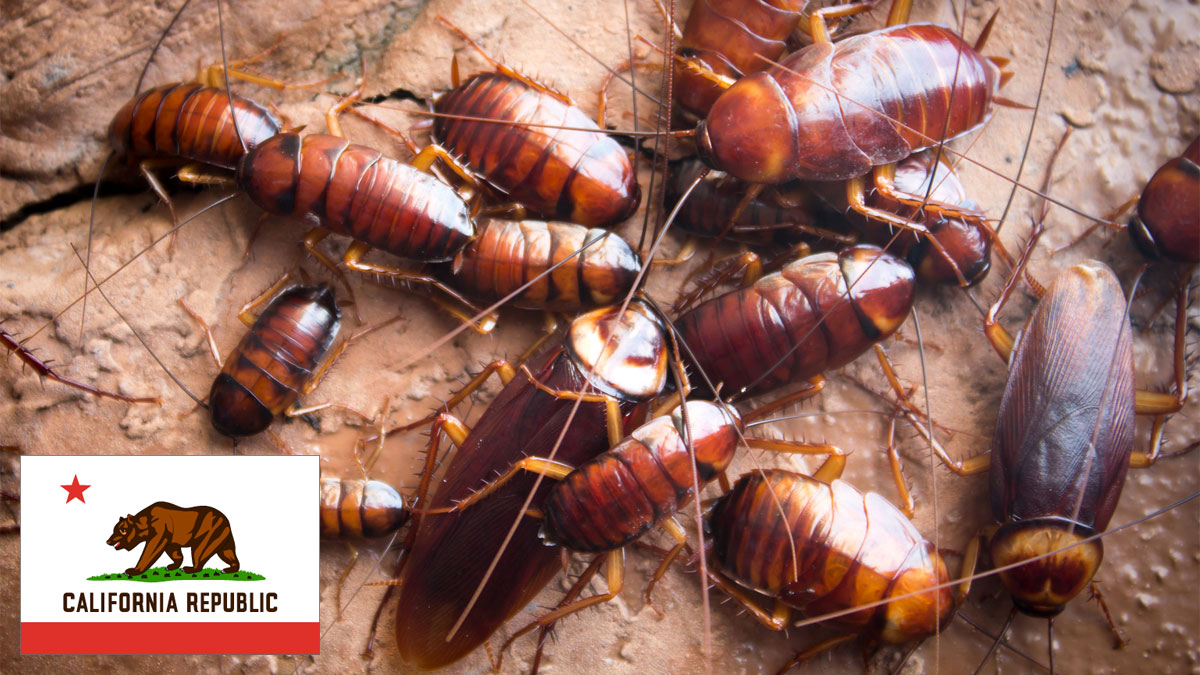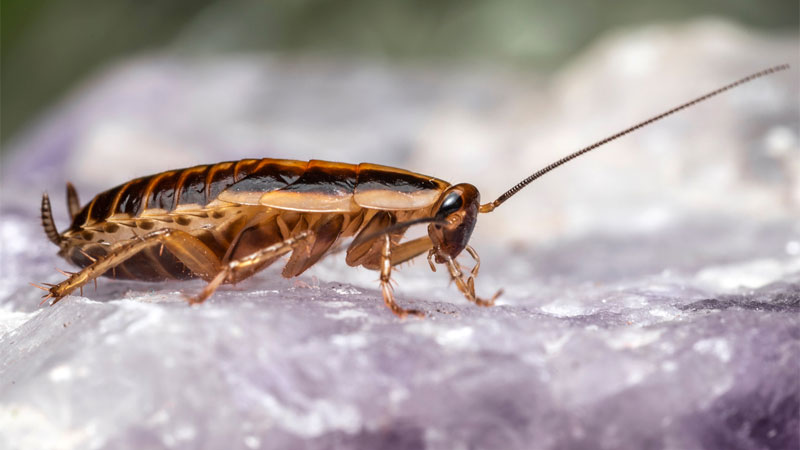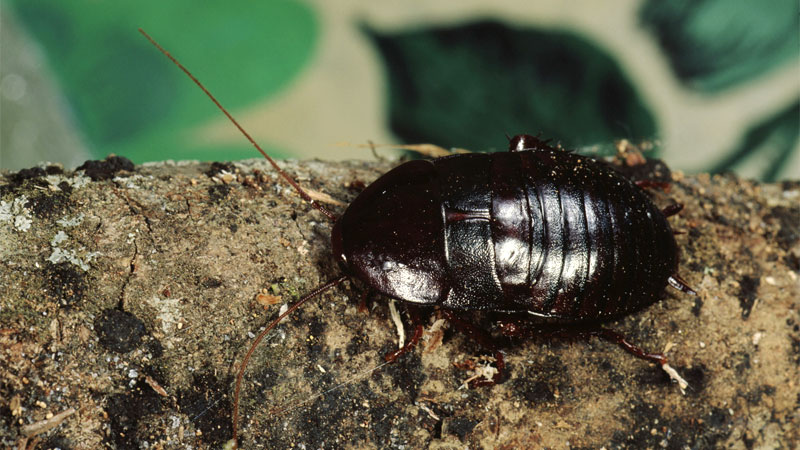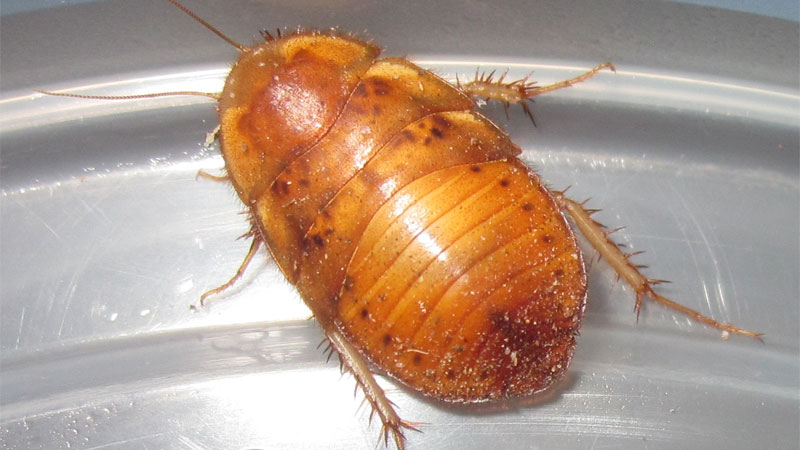California has a lot of problems, but you probably haven’t thought about bugs being one of them. However, roaches can be found throughout the state, and we’re not talking the smokable kind.
What makes this fact less apparent is the fact that most types of cockroach never bother to enter your home. There are around 4,400 species of cockroach in the order Blattodea (as well as 3,000 species of termites) and many of these live within California’s borders.
Here are 17 different cockroach types found in the Golden State.
Types of Roaches in California
#1 – American Cockroach (Periplaneta Americana)
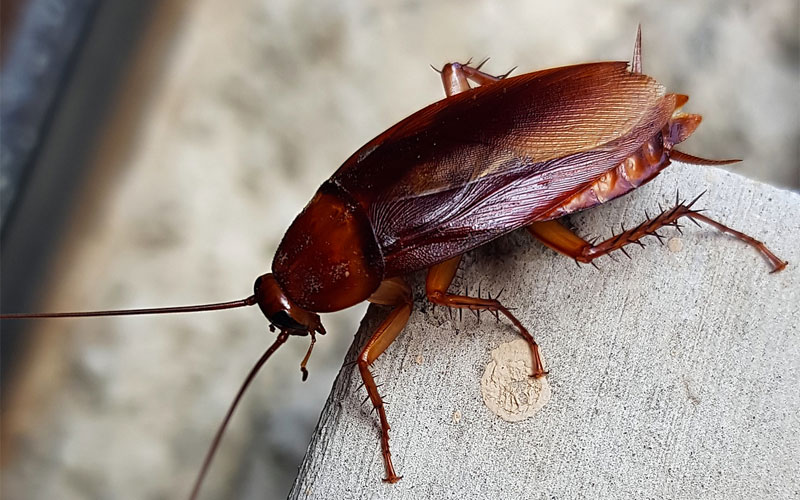
One of the most infamous cockroach species out there, American cockroaches are the largest and longest living of the common roaches. They’re also one of the most common home invaders. What makes them especially frustrating is their ability to live for about 700 days, laying as many as 150 eggs per year.
You can identify this cockroach by its reddish-brown body and yellow ring on the thorax. They’re notorious for carrying diseases and may transport as many as 22 different pathogens.
Getting rid of them can be difficult, as this species quickly builds a resistance to pesticides if the same one is used too often.
#2 – Arenivaga investigata
This sand roach has a particular claim to fame – it was added into the Arenivaga genus in 1969, the only species to be added from 1920 until a major revision was proposed in 2014. This is a pretty big deal, since we now know the genus has more species native to the US than any other cockroach genus.
It can be found throughout southeastern California into Arizona, Mexico, and Nevada. As with most members of this genus, the body is an orange-brown with nearly indiscernible markings.
#3 – Arenivaga nalepae
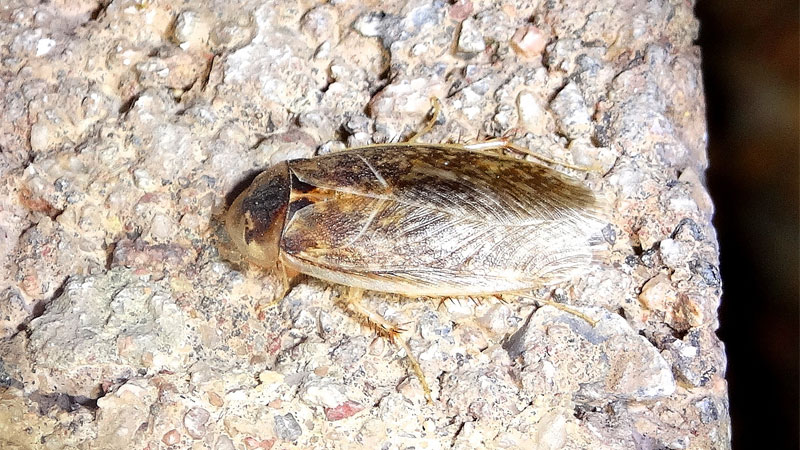
This is a pretty rare species with a range bordered by Baja California Norte, Mexico, San Felipe, and Saline Valley Salt Marsh. Arenivaga nalepae are a light sandy orange-brown color, and only invade homes when the temperature drops to abnormally low (for that region) temperatures.
Due to how similar it looks to fellow members of its genus (and the fact that this genus was only updated once between 1920 and 2014), very little is actually known about this particular roach.
#4 – Arenivaga Sequoia
This species gained fame for being the first desert sand roach to be found living in a forest – the Sequoia National Forest, to be precise. Oddly enough, not a lot is known about Arenivaga Sequoia, despite inhabiting the western portions of central and south California as well as one island.
They have a generally chestnut brown coloration that is known to display some variation from one specimen to the next. They also have wings that extend well beyond their body.
#5 – Australian Cockroach (Periplaneta Australasiae)
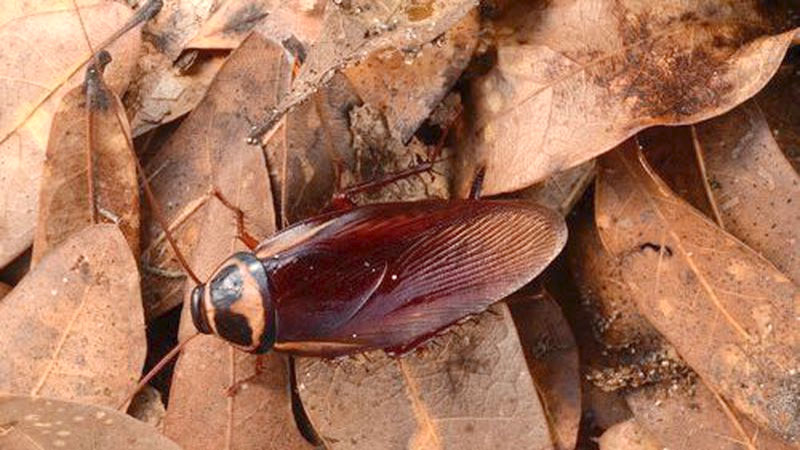
While this roach prefers the great outdoors, it’s known for hanging around outside buildings in hopes of some tasty garbage. It has a brown body with a yellowish thorax that contains two large black spots.
The feces of this cockroach is known to trigger allergic reactions as well as contaminating food when the roach does wander indoors. Thankfully, this species isn’t fond of indoor life and will usually only remain to avoid cold weather and wander back outside as temperatures rise again.
#6 – Brown Cockroach (Periplaneta Brunnea)
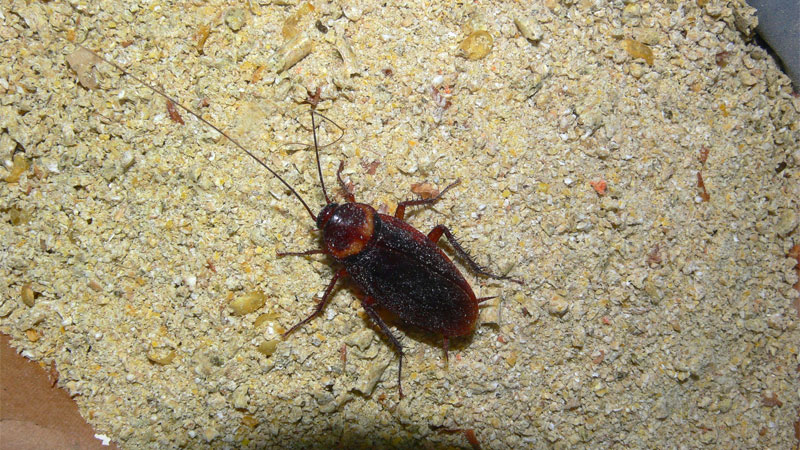
This common household pest has a very similar appearance to the American cockroach. However, it has a wider, more triangular pair of cerci and slightly darker coloration.
Brown cockroaches have adapted to living in homes near pantries or other sources of food (even your fridge), attacking everything from meats to produce. When not sheltering near food storage, it can be found in dark, damp locations such as basements.
One of the things that makes this species particularly problematic is its ability to produce an ootheca containing an average of 24 eggs, although it doesn’t breed as often as some other roach species. It has fully developed wings and will seek shelter indoors in cooler climates.
#7 – Brown-Banded Cockroach (Supella Longipalpa)
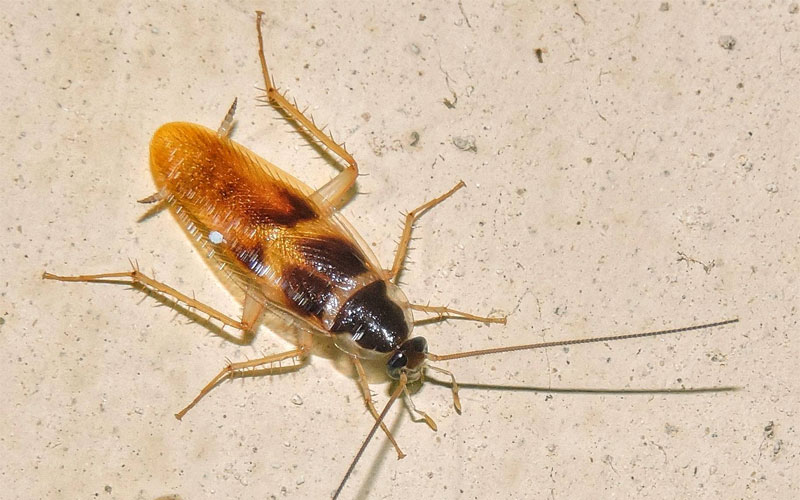
While not as notorious as the Big Three (American, German, and Oriental), this common household pest sure does cause a lot of problems. It’s a major disease vector and can spread quickly throughout large buildings.
As its name implies, this roach has two light colored bands stretching across its abdomen and wings. These wings are longer on males than females, sometimes obscuring the bands.
Interestingly enough, this roach has only begun the journey to becoming cosmopolitan in the past several decades, with the first recorded sightings in California occurring around 1940.
See Also: Are Cockroaches and Shrimp Related?
#8 – Field Cockroach (Blattella Vaga)
Living for only a few months, this species has found its way to the Americas where it feeds primarily on decomposing vegetation. It has a distinctive shiny golden coloration and is known to invade homes only when the weather gets too hot.
The first specimens in California were collected in 1933 and described two years later. Both males and females are capable of flight and, as with many species that aren’t commonly indoor pests, aren’t repelled by light.
These two factors have allowed the species to migrate long distances, with specimens discovered in Alabama in 2016 and verified in 2018. It is believed they will continue to expand their territory into Florida and the southern Atlantic states.
#9 – German Cockroach (Blattella Germanica)
Alongside the American cockroach and the Oriental cockroach, this is one of the Big Three. Despite having a short lifespan, they’re prolific breeders, allowing them to quickly infest homes.
German cockroaches have a low tolerance for cold and discovered centuries ago (or perhaps even longer) that humans provide some really cozy shelters. As a result, this species can now be found in almost every part of the world outside of Antarctica.
#10 – Hairy Desert Cockroach (Eremoblatta subdiaphana)
This pale golden cockroach prefers desert-like conditions and has a range from California to Texas. It’s not a fan of the indoors and isn’t known to invade homes.
While capable of flight, it has a very limited range and is among those species that dislike light.
#11 – Oriental Cockroach (Blatta Orientalis)
Oriental cockroaches have a black body with brown wings. They have a reputation for leaving behind a foul odor when excited or scared and can be extremely difficult to exterminate.
Unlike most cockroaches, this one tends to take its time moving around. However, they’re also one of the hardest roaches to exterminate, making their presence in your home a nightmare.
#12 – Smoky Brown Cockroach (Periplaneta Fuliginosa)
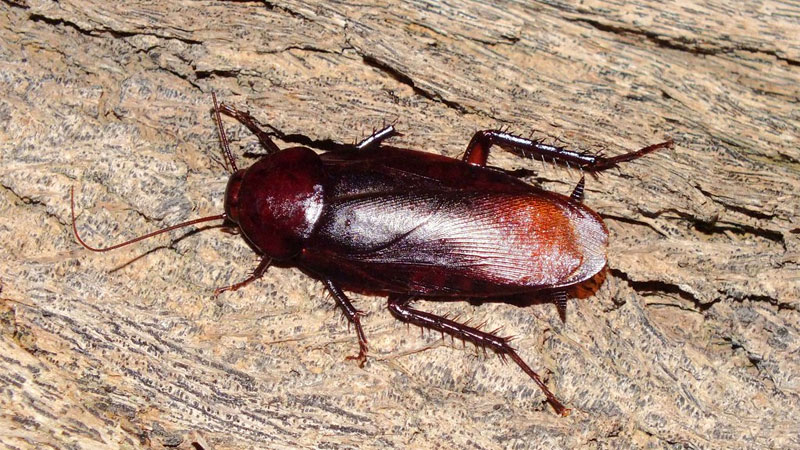
This roach may not be one of the Big Three, but it could certainly be a contender. It’s closely related to the American cockroach and is a mostly uniform mahogany color. You’ll often find these roaches camping out near garbage cans or other places where humans may leave their trash.
It’s well-known for dehydrating quickly, which encourages it to flee indoors if the temperature gets too hot or cold. Once inside, it will stick around and scavenge rotting or discarded food. This can include pet food, crumbs (even around your dishwasher or microwave), or spills you haven’t cleaned up yet.
Female smoky brown roaches are also known to invade homes to lay their eggs in warmer conditions.
Read Also: Do Cockroaches Bite People?
#13 – Surinam Cockroach (Pycnoscelus Surinamensis)
Better known as the greenhouse cockroach, this little nuisance gets its name from a preference for infesting greenhouses. One inside, it will hide until nighttime, at which point the plants become an open buffet.
People usually don’t consider the Surinam cockroach to be a pest because it rarely invades homes. However, there are plenty of products out there to deal with this species, regardless of their lack of a reputation.
#14 – Three-Lined Cockroach (Luridiblatta Trivittata)
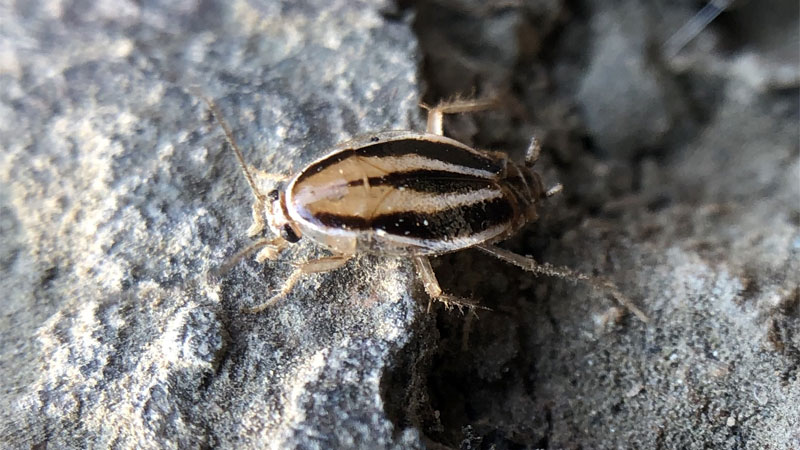
These roaches have a distinctive striping made of darker brown on their light brown bodies. While they much prefer the outdoors, one might occasionally wander inside in search of food.
However, they aren’t keen on raising families indoors. Because they’re not seen as overly problematic, there are very few products on the market designed to kill them.
#15 – Tonkawa Sand Roach (Arenivaga Tonkawa)
Found throughout Central America and up through Texas and Arizona into California, this species is one of the better known members of its genus. They have a transparent exoskeleton during their early life which eventually turns brown.
Only the females are able to fly, although their range is limited. But that’s not where their claim to fame lies – they’re commonly bred as food for insectivore pets.
#16 – Turkestan Cockroach (Shelfordella Lateralis)
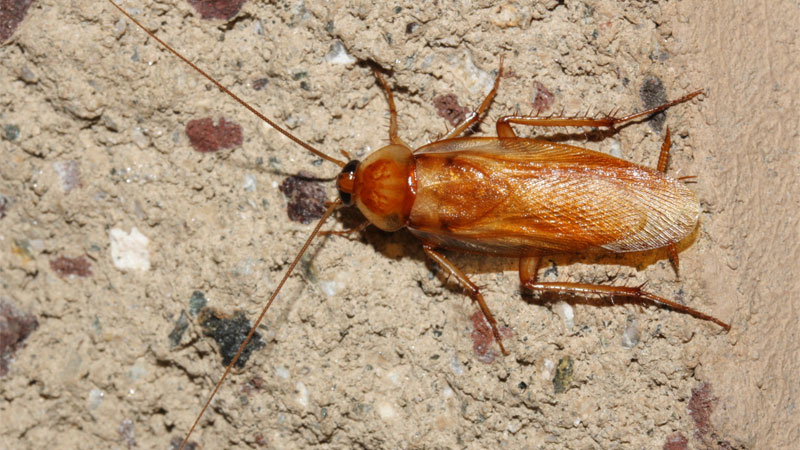
These cockroaches normally remain outdoors but have been known to invade homes in more tropical regions. They’re sometimes referred to as the rusty red cockroach due to their coloration.
Being a species that has the ability to fly is what often leads to seeing them in your house. However, they have a reputation in California for being highly destructive pests regardless of whether or not one wanders inside.
#17 – Western Wood Cockroach (Parcoblatta Americana)
This particular California cockroach is actually an invasive species that has proven problematic – not for being pests in human habitations, however.
Instead, this roach likes to invade harvester ant nests where it mooches off of them. They have a lot of variation in color and size, directly influenced by how arid their environment is.
See Also: How to Get Rid of Wood Roaches
- How to Get Rid of Hawks - March 8, 2024
- How to Get Rid of Pill Bugs (Rolly Pollies) - March 1, 2024
- How to Get Rid of Groundhogs (Woodchucks) - February 5, 2024

